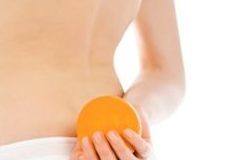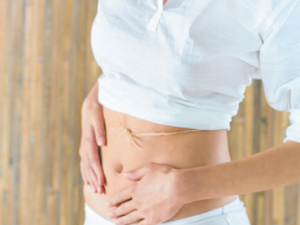KARINA LIZ IS FEATURED IN BEST HOLISTIC LIFE MAGAZINE!

The Best Gift You Can Give Yourself This Holiday Season Is A Healthy Cleanse!
Click on link and flip to PAGE 58 to see full article: CLICK HERE
BLOOMING WATERS FEATURED IN BYRDIE MAGAZINE!!!
NY AND LA GIRLS ARE ALL SECRETLY GETTING THIS DE-BLOATING TREATMENT
 I heard about it the way one hears about any taboo beauty treatment: Over white wine and crudités at the Chateau Marmont. I was there having breakfast with a few beauty editors and some publicists from a high-end makeup brand won’t mention for reasons you’re about to find out. In between sips of Sauvignon Blanc and discussions of how much dairy is too much dairy, one of the women in our group casually mentioned that on days when she feels bloated, she and her friends in New York all swear by an unmentionable service offered by a chic, secret facility in the Flatiron called “Fluid Water Therapy.”
I heard about it the way one hears about any taboo beauty treatment: Over white wine and crudités at the Chateau Marmont. I was there having breakfast with a few beauty editors and some publicists from a high-end makeup brand won’t mention for reasons you’re about to find out. In between sips of Sauvignon Blanc and discussions of how much dairy is too much dairy, one of the women in our group casually mentioned that on days when she feels bloated, she and her friends in New York all swear by an unmentionable service offered by a chic, secret facility in the Flatiron called “Fluid Water Therapy.”
WHAT IS THE PROCEDURE ACTUALLY LIKE?
WHEN DID PEOPLE START DOING IT?
WHAT’S THE SCIENCE?
ARE THERE ANY DOWNSIDES?
SHOULD YOU GET ONE?
CATE BLANCHETT LOVES A COLONIC CLEANSE
 Australian actor Cate Blanchett revealed she’s a fan of a good old fashioned colonic cleanse.
Australian actor Cate Blanchett revealed she’s a fan of a good old fashioned colonic cleanse.
“I think it’s good every now and then to have a colonic,” she told Yahoo Beauty. “Not every day, but every now and again, because it’s super hydrating.”
Her other wellness tips include “don’t drink, don’t smoke” and get plenty of sleep.
The 46-year-old also talked about her disdain for social media.
“The like and the dislike is just totally primary schoolyard. I cannot for the life of me work out why adults are participating in that s**t,” said Blanchett.
She said it’s “pathetic” when people take selfies and worry about what other people think of them.
“I just can’t handle it. Of course you want people to go see the films that you make, of course you want them to enjoy them. But I’m not out there saying, ‘Do they like the way I look? Do they like that look on the red carpet?’ You have to say, ‘This is what I’m doing right now,”‘ she said.
Blanchett is not on social media, for better or worse.
“I probably do miss out on a lot of stuff – I probably go to less parties than I would like,” she said.
Her film Carol will premiere in Australia at the Adelaide Film Festival on October 18 and in New Zealand next year on February 11 .
– AAP
JENNIFER ANISTON CREDITS INFRA RED SAUNA AND WATER TO HEALTH & BEAUTY
 From anyone else, the admission that plenty of water and sleep are the best way to attain a glowing complexion tends to elicit an automatic eye roll. But when Jennifer Aniston mentions—without any hint of pretense—that it’s the best beauty secret she has in her arsenal, I find myself nodding along in agreement (never mind that she can’t see me over the phone).
From anyone else, the admission that plenty of water and sleep are the best way to attain a glowing complexion tends to elicit an automatic eye roll. But when Jennifer Aniston mentions—without any hint of pretense—that it’s the best beauty secret she has in her arsenal, I find myself nodding along in agreement (never mind that she can’t see me over the phone).
Of course, hydration and rest are just the cornerstones of the actress and Aveeno spokeswoman’s routine, which she rattles off in full during our call. The list, which echoes her easy aesthetic, includes a tightly edited skincare regimen, rotating workout options and a tendency toward moderation.
Below, our chat on all things beauty, from budget bar soaps to slightly pricier infrared saunas.
On her daily beauty routine:
“It’s actually quite simple, the routine—and it’s been pretty much the same routine for a long time, since I’m a creature of habit. I wash my face with my Neutrogena Cleansing Bar, and then I usually use a toner, whatever toner of the month I’m using. And serum, depending on what serum I’m using at the time. And then I use my Aveeno Daily Radiance Moisturizer, which has SPF 15—I usually mix into that the Aveeno sunscreen 30. So I mix them together and put them on my face; psychologically, it doesn’t make me feel like I’m loading on layers and layers of cream. That’s about it!”
On her go-to summer makeup look:
“I’ve been taking a break from the sun for the last couple years, and that might be a permanent one. So I usually do a bronzer of some sort and then a light eye and a rosy lip—a rosy-plummy kind of lip or a nude lip. My makeup’s pretty basic.”
On her fitness favorites:
“I actually have an injury so I haven’t been able to run, which I love more than anything—it’s what makes me feel like I get a really good workout. But I’ve also been loving the barre method lately, mixed in with spinning. I just like to mix things up, and also I really love an infrared sauna; it just allows for such beautiful, glowing skin and cell rejuvenation and detoxification. It even helps with weight loss and relaxation.”
On dieting fads:
“It’s really important, moderation. I don’t think crash diets are good. They’re all fads, whether it be the bulletproof coffee, paleo…they’re all versions of the same thing. Cutting out complex carbs is always a good thing, but I think you should always be able to have your pasta now and then, if you want it. If you’re healthy—you work out and you don’t overindulge in sugar or alcohol—you’re great.”…
On the best beauty secret she’s learned:
“Honestly, and I’ve said it: it’s sleep, and water water water water water! Those are the two key ingredients.”
MAYO CLINIC FINDS BENEFITS WITH INFRARED SAUNA
 An infrared sauna is a type of sauna that uses light to create heat. These saunas are sometimes called far-infrared saunas — “far” describes where the infrared waves fall on the light spectrum. A traditional sauna uses heat to warm the air, which in turn warms your body. An infrared sauna heats your body directly without warming the air around you.
An infrared sauna is a type of sauna that uses light to create heat. These saunas are sometimes called far-infrared saunas — “far” describes where the infrared waves fall on the light spectrum. A traditional sauna uses heat to warm the air, which in turn warms your body. An infrared sauna heats your body directly without warming the air around you.
The appeal of saunas in general is that they cause reactions, such as vigorous sweating and increased heart rate, similar to those elicited by moderate exercise. An infrared sauna produces these results at lower temperatures than does a regular sauna, which makes it accessible to people who can’t tolerate the heat of a conventional sauna. But does that translate into tangible health benefits? Perhaps.
Several studies have looked at using infrared saunas in the treatment of chronic health problems, such as high blood pressure, congestive heart failure and rheumatoid arthritis, and found some evidence of benefit. However, larger and more-rigorous studies are needed to confirm these results.
On the other hand, no adverse effects have been reported with infrared saunas. So if you’re considering trying a sauna for relaxation, an infrared sauna might be an option.
KING LOUIS XIV RULED FRANCE 72 YEARS (longest reign in modern European history) & CREDITED HIS LONGEVITY TO COLONICS!
 From ancient pharaohs to the kings of France, the upper crust loved their enemas.
From ancient pharaohs to the kings of France, the upper crust loved their enemas.
Ah, the enema. Shooting warm liquid into the rectum through the anus as a quick fix for what ails you has a history as long as the human colon itself. Like bleeding and cupping, the enema has been touted as a cure-all ever since doctors were penning their prescriptions on papyrus. Used by folk-healers and physicians alike, this particular form of therapy reached an art form in pre-revolutionary France, where more people probably had daily enemas than brushed their teeth.
The first mention of the enema in medical literature comes from Ancient Egypt. No surprise there. What is unusual, however, is that the enema was considered such an essential component of good health that every pharaoh had his own so-called “Guardian of the Anus.” Both the Edwin Smith Papyrus (c.1600 BC) and the Ebers Papyrus (c. 1550 BC) — two of the earliest known medical documents — mention enemas in detail. Ancient Greek writings corroborate the Egyptian preoccupation with colonic cleanliness. In 500 BC, Hippocrates and his followers began to advocate health by enema as well, as did the eternally popular Galen, some 650 years later.
Back in ancient times, enemas were believed to cure a wide range of physical ailments and not just those related to digestion and excretion. Headaches, sexual dysfunction, allergies, asthma, childbirth, fevers, even the common cold — all were supposedly helped by a good rectal purging. The enema’s powers were so revered that the procedure itself bordered on the sacred. As such, it was an essential part of many religious rituals in Egypt and elsewhere.
The cleansing ritual became a critical part of many spiritual ceremonies across an astounding variety of cultures. The people of ancient Babylonia, India, China and Africa all believed in the bag. Actually, the common delivery systems back then differed greatly from the comfortable and flexible rubber tubing and bulbs of today. The most common enema devices consisted of hollowed-out animal bones attached to liquid-filled gourds or animal bladders. Sometimes, instead of just letting the time-tested scientific principle of gravity do its work, designated blowers were recruited to help the process along.
WACKY TOBACCY
In the Americas, dating from around the beginning of the Common Era, the Aguaruna Indians of Peru and many Mayan tribes were also known to use ritual and therapeutic enemas to empty their bowels, as evidenced by the many explicit yet artistically rendered scenes on their art and pottery. Unlike the straight-laced Egyptians, who generally employed a traditional warm-water solution, the Mayans got a little playful with their enemas. The alcoholic and hallucinogenic ingredients mixed into their concoctions must have led to more than a few wild evenings.
Around the same time, Native Indian cultures were using tobacco enemas as part of their religious worship as well as in rite-of-passage rituals. Pubic and anal areas were shaved, prayers were recited, the requisite solutions or smokes were injected, and then the families celebrated. Of course, many tribes employed tobacco enemas for purely recreational purposes, too. We can only pray that today’s ever-scheming tobacco industry will leave that little marketing strategy in the vault.
PUBLIC ENEMA NUMBER ONE
Though enemas never really went away, it was the pre-revolutionary French, taking a cue from their much-adored monarch, who carried an enthusiasm for enemas to the extreme. To say Louis XIV (1638-1715) was fond of enemas would be a vast understatement. The Sun King was such a fervent advocate of the procedure that he reportedly had thousands and thousands of them in his lifetime. Though the idea of the enema was much the same as in ancient times, the delivery system had evolved quite a bit. Instead of a simple bone and bottle, the clyster syringe, with its specially designed rectal nozzle and plunger, helped propel the solution into the rectum with gusto.
Enemas proved addictive to the charismatic monarch. In the beginning, every night after dinner, Louis would briefly excuse himself to indulge in a little postprandial flush. But after a few years, derriere douching became so popular that the stigma attached to it fell by the wayside. People would enjoy some three or four lavements a day. It wasn’t long before Louis would actually confer with his advisors and hang out with his buddies while receiving his enemas.
And the trend wasn’t reserved for royalty alone. Any fashionable lady who desired a beautiful complexion had to have enemas administered on a regular basis by servants who were experts in the task. Those slightly embarrassed by the prospect, but still desiring its beneficial effects, might purchase one of the special, bent clyster syringes, designed for self-application. Alternatively, there was an optional buttocks-cover attachment, for those modest ladies too squeamish to attend to their lavements all by themselves. Most women, however, were not modest about enemas at all. A famous account in the memoirs of the Duc de Saint-Simon (1675 -1755) had the Duchess of Bourgogne chatting with the king during a crowded party while her loyal maid crawled beneath her bejewelled evening gown to administer an enema.
As for the king and his own beloved bottom boosts, he credited them as the reason behind his health and longevity. Perhaps there was something to his cleansing clysters: Louis XIV ruled France for 72 years, the longest reign in modern European history. Or maybe he was just a garden-variety klismaphiliac, deriving sexual pleasure from the procedure.
MODERN MEDICINE
Up until about 100 years ago, anything less than one bowel movement a day was considered abnormal, so virtually every household had an enema bag hanging on the back of the bathroom door. While they were once routinely prescribed for irregularity and before childbirth, the idea of therapeutic enemas has now pretty much been flushed down the drain. With the development of more effective drugs, suppositories and laxatives, most modern MDs pooh-pooh the procedure as outdated and unnecessary except in such diagnostic treatments as barium enemas, or, occasionally, pre- or post-surgery.
But mainstream medical opinion may not necessarily spell the end for society’s rear-door fixations. We need only look to the popularity of the latest pseudo-medical craze — colonic irrigation. Unlike enemas, which flush out only the sigmoid portion of the colon, colonic irrigation goes the whole nine yards — or two yards, rather — from rectum to cecum. Many proponents of alternative medicine have held the enema up as the be-all and end-all for a variety of ailments; the best way to cleanse your body and system of notorious “toxins.” Janet Jackson herself has claimed that coffee enemas cured her of a two-year bout with depression by washing away her “sad cells.” Doctors may scoff, but with British royalty (Princess Diana) and American royalty (Hollywood starlets) praising its virtues, the constipated, toxic masses have been quick to take up the tube.
A few more reputable sources have also been wondering whether or not this old-fashioned remedy might be helpful even by today’s medical standards. The fuss focuses on the potential cancer-fighting qualities of the coffee enema. Long heralded as the ideal colonic cleanser by proponents of alternative medicine, it was even included in the well-respected Merck Manual of Diagnosis and Therapy until 1972. The National Institutes of Health recently jumped on the java-injection bandwagon by funding a $1.4 million clinical trial at Columbia University, which hopes to determine whether or not coffee enemas, in conjunction with pancreatic enzymes and supplements, might help fight pancreatic cancer by helping the liver more efficiently dispose of dead cancer cells. The results are not yet in, but patients in the pilot study lived 17.5 months, nearly triple the average survival period. It seems this particular caffeinated clyster might actually live up to all the buzz.
LEONARDO DICAPRIO’S COLON HYDROTHERAPY SECRET
 Leonardo DiCaprio’s former girlfriend introduced him to colon hydrotherapy.
Leonardo DiCaprio’s former girlfriend introduced him to colon hydrotherapy.
The Django Unchained actor became a regular at The Piper Center for Eternal Wellness in New York where he became a fan of the treatment which is described by the facility as “a safe, effective method of removing waste from the large intestine, without the use of drugs”.
However since breaking up with Erin Heatherton Leonardo hasn’t continued with the treatment. A source told the Huffington Post: “Leo was introduced to them by [former] girlfriend Erin Heatherton and goes to The Piper Center for Eternal Wellness on Spring Street. While he was dating Erin, he went four times and was last seen leaving the center on August 22, but hasn’t been back since he broke up with Erin. Like a lot of guys, Leo took a while to be convinced to try one,” the insider said. “It can be very embarrassing, but now that he has had one, he loves it.”
https://www.inquisitr.com/445006/leonardo-dicaprio-uses-colonic-irrigation/
DOES COLONIC IRRIGATION REALLY WORK?
Karina says “Check out this girl’s experience with colon hydrotherapy. I actually know Anna Paredes, as she was my own Colon Hydrotherapist for many years in Sydney, Australia. Her business has expanded and she now owns 3 clinics. Her practice, however, uses the closed system, whereby the therapist guides the insertion of the speculum, and water and waste take turns alternating through the tube (water up, then waste down). The LIBBE system, used in my business, is a more modern device where YOU insert the speculum in your privacy (no guidance), and control the flow of water/waste, which exit at the same time. Gentler on the body and, in my experience, more effective! Nonetheless, the benefits of a colonic, whether using the open or closed system are the same. Have a read!”
Can a jet of water up your rear-end wash away your health problems?
I’m not sure what was more frightening – the thought of undergoing a colonic irrigation or of having my experience written up for all to read.There’s nothing glamorous about a jet of water shooting up your rear end. Yet in recent years, colonic irrigation has become the celebrity health fad du jour; Goldie Hawn and Demi Moore are fans. Devotees claim just one treatment boosts health and vitality and cures everything from acne and irritable bowels to depression. Colonic therapists say it will also strengthen the digestive tract, heighten energy, stimulate the immune system and, of course, induce clockwork regularity. With all this in mind I laid myself, and my dignity, on the table.
Royal flush
Anna Paredes, the colon hydrotherapist at Sydney’s Colon Care Centre and president of the Australian Colonic Hydrotherapy Association, has been cleansing colons for more than 15 years. She says up until five years ago it was only hippies, medical practitioners and alternative therapists who had colonics. “These days colonics are becoming increasingly common among average Australians,” Paredes says. “Their diets are highly processed and soon their bodies say, ‘Enough!'” For best results, Paredes says to avoid bread, sugar and alcohol for three days before my treatment.
But as it’s my birthday the day before, I fail miserably. Paredes quizzes me on the amount of water I consumed versus the amount of alcohol – one glass of wine depletes the body of about three glasses of water, so my colon is in need of hydration.
Awkward is the only way to describe having a speculum and plastic hose inserted into your rectum, but once in place you hardly notice it is there. The other end of the hose is connected to a machine. With a flick of the switch, water flows into my digestive tract. There is little discomfort initially, but then the pressure builds and I feel a cramp on my right side.
“A blockage,” Paredes says as she flicks the release switch. From the murky mixture in the tube she concludes I eat too much sugar. After the second release I start to feel nauseous, which Paredes says means toxins are being eliminated.
Up to 40 litres of warm water is pumped in and flushed out of my colon. Waste, toxins and bacteria are washed away, leaving my internal plumbing squeaky clean. I can’t say I feel fabulous after the treatment. Lighter, yes, but the nausea remains for a few hours. However, in the following days I have a spring in my step, my skin and eyes are brighter and, by following Paredes’s nutritional tips, I’m now two kilograms lighter.
http://www.bodyandsoul.com.au/health/health+news/does+colonic+irrigation+really+workr,12889
HAVE YOU EVER HAD A COLONIC TREATMENT?
 You’ll also hear it called “colon hydrotherapy” or “colon irrigation,” which might sound like the nether regions are about to become a construction site. Fear not! So what’s colon therapy all about? Colon hydrotherapy isn’t a fad of new age alternative health. The treatment was actually developed in the early 20th century, and use of enemas (similar to colonics) and beliefs surrounding colon impurity have been around since ancient Egypt. Proponents of colon therapy believe that our bodies don’t fully dispose of waste materials and toxins, which can accumulate and lead to a host of medical problems. This is called “auto-intoxication,” which sounds terrifying but as of yet has not been validated by mainstream medicine.
You’ll also hear it called “colon hydrotherapy” or “colon irrigation,” which might sound like the nether regions are about to become a construction site. Fear not! So what’s colon therapy all about? Colon hydrotherapy isn’t a fad of new age alternative health. The treatment was actually developed in the early 20th century, and use of enemas (similar to colonics) and beliefs surrounding colon impurity have been around since ancient Egypt. Proponents of colon therapy believe that our bodies don’t fully dispose of waste materials and toxins, which can accumulate and lead to a host of medical problems. This is called “auto-intoxication,” which sounds terrifying but as of yet has not been validated by mainstream medicine.
Nonetheless, fans and practitioners of colon therapy say there are many evidenced benefits to the treatment that modern medicine will undoubtedly verify through further research. Constipation is one condition that colonic treatments have been shown to help alleviate, but water and fiber-rich foods, like beans, oatmeal, raspberries, and broccoli, are easy and effective remedies, as well. That said, many report feeling relaxed and calm after their treatments, and we’ve heard others say they feel lighter and refreshed after colon cleansing. If you’re going to try it, take precautions against the various risks associated with colonics and do everything to make sure you get the most out of the experience.
Here are five tips we’ve gathered from the pros:
1. Read up on colon therapy and know the risks. Anything from mild discomfort in the abdomen to heart failure due to electrolyte imbalance can result as a side effect. Check with your regular health provider beforehand to make sure it’s a safe option for you.
2. Find a reputable clinic that uses disposable equipment to avoid infection. Need we say more?
3. Drink lots of water prior to and after your treatment. Colon therapy can be dehydrating, so you’ll want to counteract that by getting enough fluids into your system.
4. Be realistic about the potential outcomes of the therapy. You may not cure yourself of arthritis or lose 50 pounds, but you can still feel rejuvenated and cleansed after the procedure.
5. Be proactive about living a colon-healthy life, with or without the help of colonics.This means drinking plenty of water, eating enough fiber-rich food, and staying active.
http://www.huffingtonpost.com/the-chopra-well/colonic-_b_2066925.html
6 REASONS WHY YOU SHOULD GET A COLONIC
 Holy Holy! I just received the most amazing and deeply healing colonic from my friend. Colon Hydrotherapy aka Colonics aka sticking a tube up your bum. Why it’s important to clean, purify and purge your intestinal tract:
Holy Holy! I just received the most amazing and deeply healing colonic from my friend. Colon Hydrotherapy aka Colonics aka sticking a tube up your bum. Why it’s important to clean, purify and purge your intestinal tract:
1. Let’s say you’ve been on the planet for 30 years. That means you’re 30 years old and assuming you eat as part of being a human, there’s been food inside your body for every day you’ve since been breathing and alive. Let’s say you eat 2 meals a day x 365 days a year x 30 years. Let’s average to 2 meals a day after maybe being ill and skipping a few meals in life, being a baby and only having breast milk for the first few years, juice fasts, cleanses, whatever, etc etc. That comes to equal up to about 21,900 meals you’ve had in your system going through your digestive tract… Woah. That’s a lot. That’s a lot of work to do for the teeth, tongue, jaw, esophagus, stomach, large intestine, small intestine and anus. The act of “pooping” or “taking a sh*t” is actually quite a long process that has to move through different mechanisms of the body. A treatment to clear out any residue from these 21,000 meals might be a prudent thing to do.
2. Straight from Suki’s website, “Colonics are the gentle rinsing of the colon with warm water, to remove encrusted fecal matter, gas & mucus. This allows vital nutrients to be absorbed & leaves you feeling healthy & light. Colonics can also help re-tone & re-shape the colon. The ideal transit time of food through the body is 18-24 hours. On average in the UK it’s now 60 hours for men & 70 for women.” Did you hear that? The constipated transit time is over double the ideal healthy rate! If you feel constipated and are not going to the loo as often as you should, it may not even be from your most recent meal, it could be the “encrusted fecal matter” from years and years ago that’s stuck somewhere inside the lining of your intestines. Get a colonic! Clean your insides!
3. Egyptian hieroglyphics, the Bible, and Himalayan yogis all document ways in which to clean the bowel. That’s right, they’ve been sticking contraptions up their booty since the 4th century BCE. It’s 2012 now, which means as an evolved species and race we theoretically should all be practicing these ways of cleansing and taking care of these vehicles we live in aka our bodies. Suki says, “As the years continue to pass – if the person still eats poorly, lives under emotional stress & in a spiritual vacuity, the body then gradually becomes overwhelmed by toxicity.” Ahhh! Toxicity?! Whatever we put into our system is supposed to come out. That’s why we have one hole up top and one hole at the bottom. Toxicity in our bodies? Sounds scary! Get it out!
4. And then it gets deeper… It doesn’t just have to do with the physical aspect of food. Colonics then can reach an even deeper layer of bodymind connetions, emotional/mental baggage and energetic repatterning… I have a whole saga around my experience with Suki, but I’ll give you the short version. During colonics, warm water is softly shot up the bum and then gently released back out the bum to purge and purify the intestinal tract. My intestines were gripping onto the water. They wouldn’t release. I had to physical massage and coax my organs to let go of the water they were holding onto. WOAH. That means, I had a bodymind pattern to “seize and hold” vs. “let go and release.” And y’all are smart enough to know what that means, whatever the body is doing, the mind mirrors and vise versa. Was I conscious of this? No. Was my body reacting to an unconscious pattern? Yes. A deep energetic frequency in my body finally had the opportunity to rewire and reform into a new pattern of today vs. the history of yesterday. YES!
5. There are healers disguised as “blah blah blahs” out there in this world. They’re everywhere. They call themselves “Colonic Therapists”, “Massage Therapists”, “Yoga Teachers”, “CranioSacral Therapists”, and the list goes on, etc etc. Of course, not everyone is a “healer”. Is it ok that I use that word, healer? For some people it freaks them out—just want to be sure everyone’s clear on that word. I have a friend who says it best. He says healers can be categorized and held in two different containers. The first one holds the people who genuinely want to do good in the world to help others, so they do it- they do what they do and go about their business and purpose and THEN there are the “bonafide healers” who have simply been granted the gift to heal. Some people just have access to the gift—they have you know, “the touch.” And since we’re all yogis and conscious individuals and beings on the Path, we know that “dharma” isn’t just an aloof concept, but it actually is a grounded and embodied purpose of one’s own life.
6. And the last few bits of words on getting a colonic… For best results, do a juice cleanse 3 days before or if that sounds undoable, fresh veggies and fruits for meals. Oh and one more thing: relax your bum. Have fun! Om Shanti!

